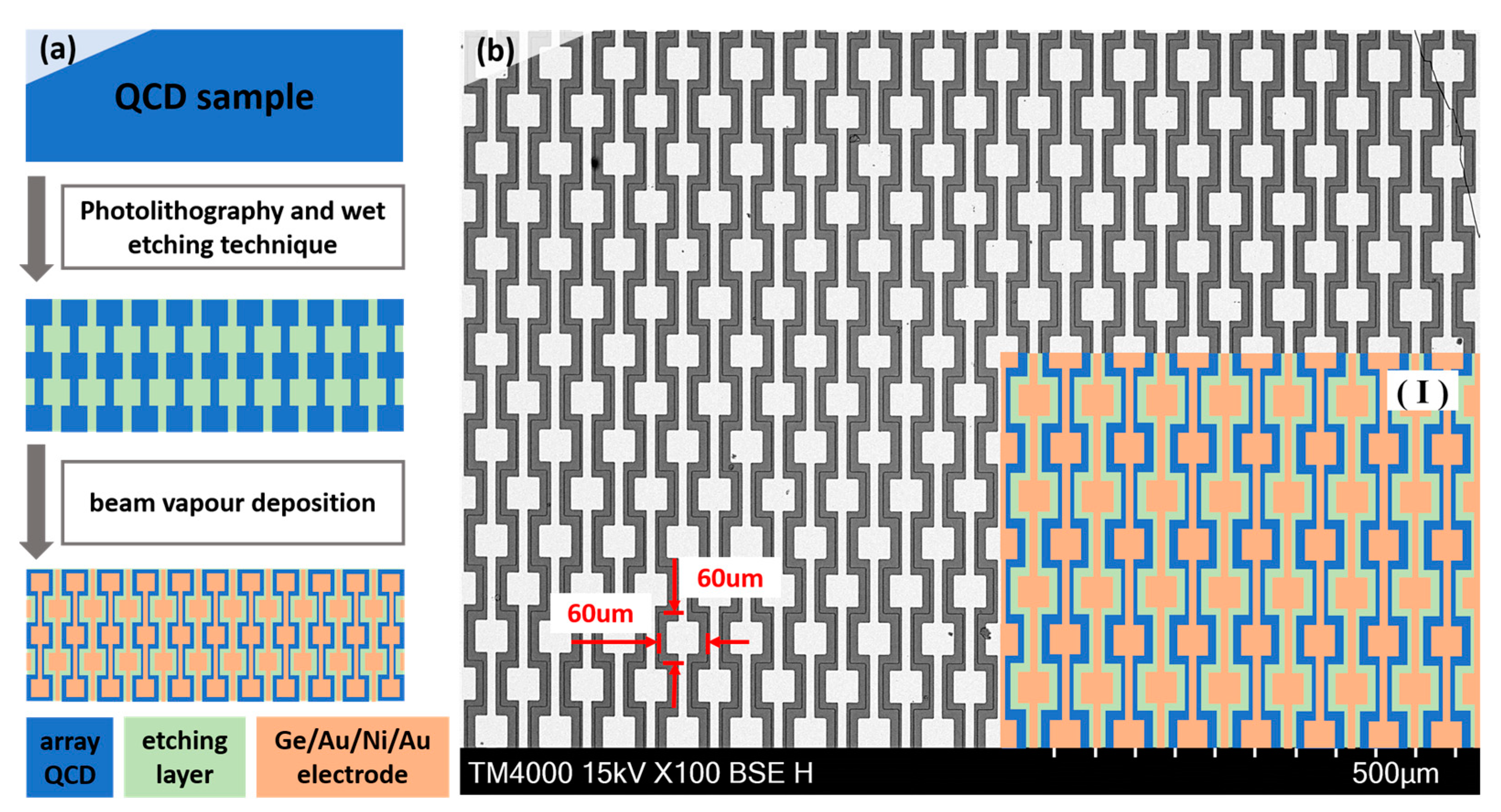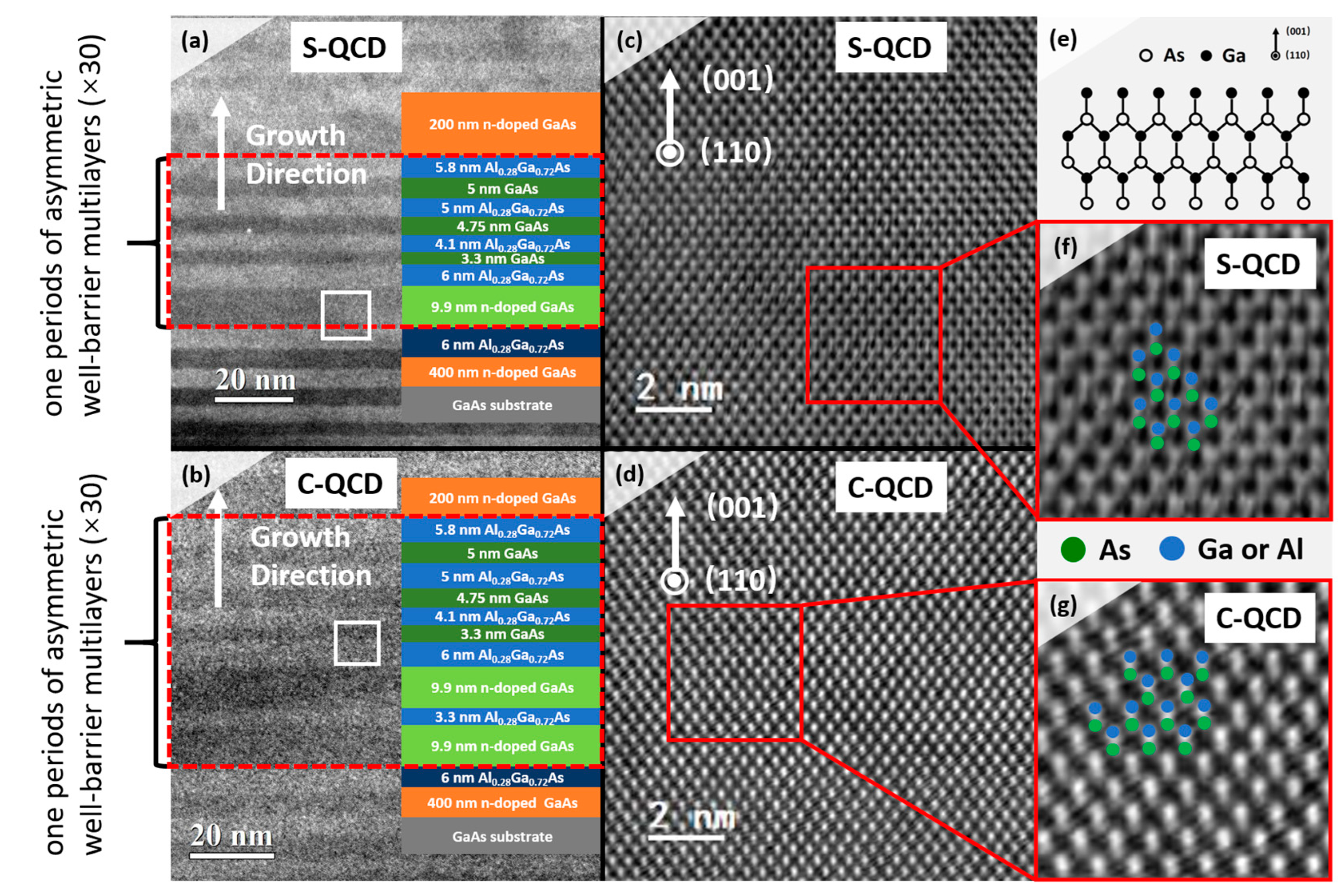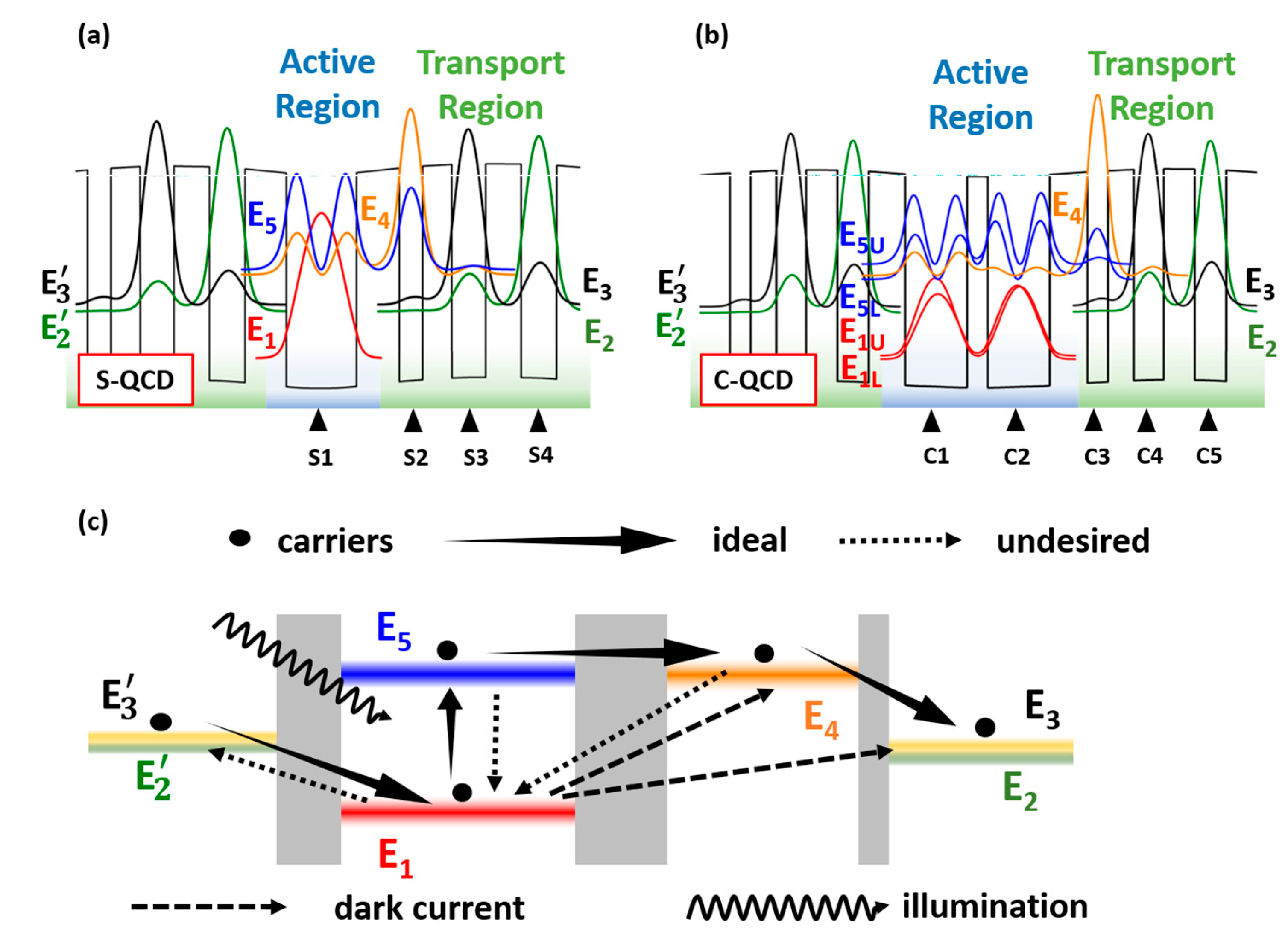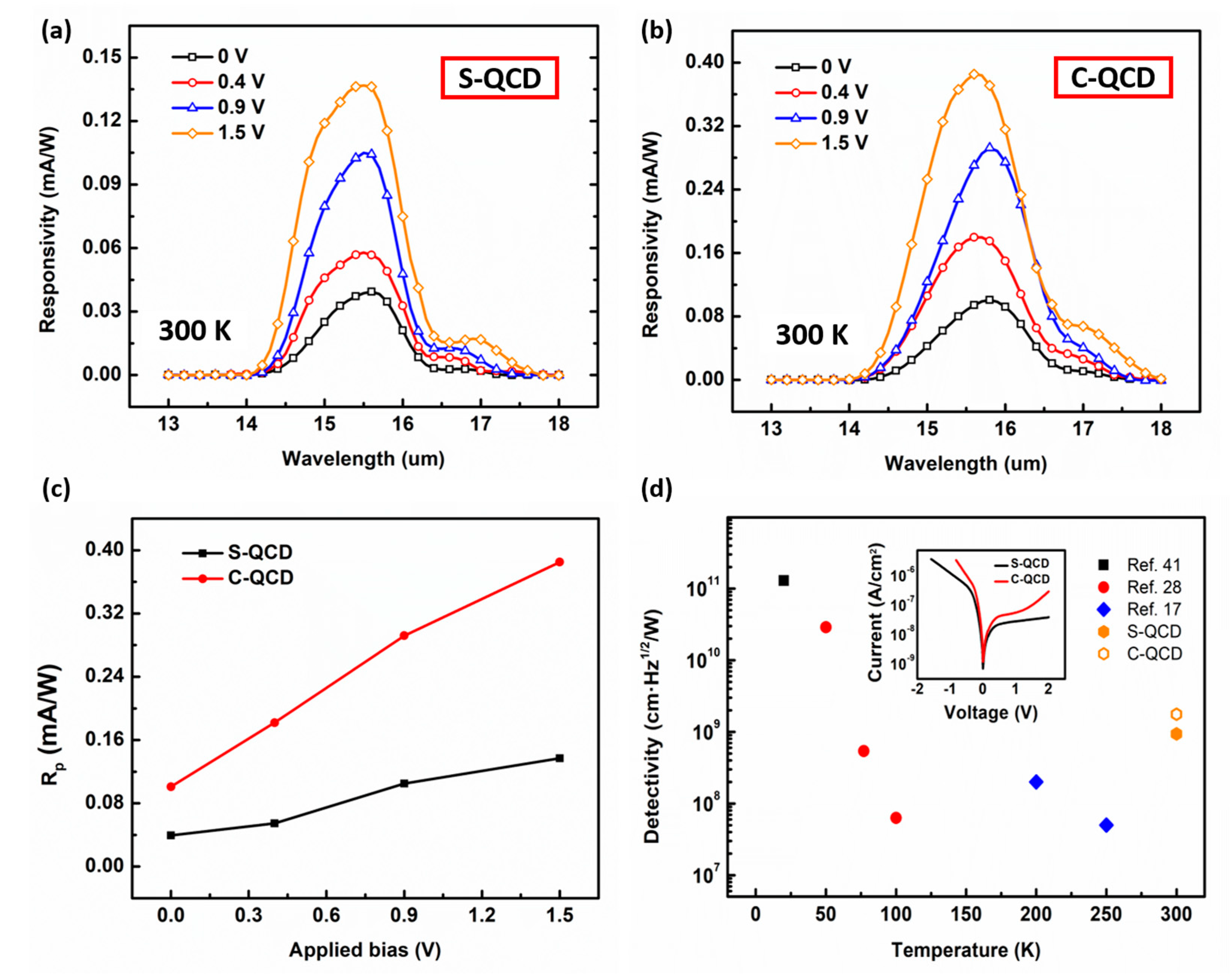Room-Temperature Response Performance of Coupled Doped-Well Quantum Cascade Detectors with Array Structure
Abstract
:1. Introduction
2. Experimental Details
3. Results and Discussion
3.1. Normal Incident Irradiation
3.2. Microstructure and Band Structure
3.3. Response Performance and Detectivity
3.4. Energy Level Interaction
3.5. Redistribution of Electrons
4. Conclusions
Author Contributions
Funding
Data Availability Statement
Acknowledgments
Conflicts of Interest
References
- Livache, C.; Martinez, B.; Goubet, N.; Gréboval, C.; Qu, J.; Chu, A.; Royer, S.; Ithurria, S.; Silly, M.G.; Dubertret, B.; et al. A colloidal quantum dot infrared photodetector and its use for intraband detection. Nat. Commun. 2019, 10, 2125. [Google Scholar] [CrossRef] [Green Version]
- Onaran, E.; Onbasli, M.C.; Yesilyurt, A.; Yu, H.Y.; Nayfeh, A.M.; Okyay, A.K. Silicon-Germanium multi-quantum well pho-todetectors in the near infrared. Opt. Express 2012, 20, 7608–7615. [Google Scholar] [CrossRef] [PubMed]
- Gendron, L.; Koeniguer, C.; Marcadet, X.; Berger, V. Quantum cascade detectors. Infrared Phys. Technol. 2005, 47, 175–181. [Google Scholar] [CrossRef]
- Hainey, M.F.; Mano, T.; Kasaya, T.; Ochiai, T.; Osato, H.; Watanabe, K.; Sugimoto, Y.; Kawazu, T.; Arai, Y.; Shigetou, A.; et al. Systematic studies for improving device performance of quantum well infrared stripe photodetectors. Nanophotonics 2020, 9, 3373–3384. [Google Scholar] [CrossRef]
- Tkach, M.V.; Seti, J.O.; Voitsekhivska, O.M.; Pytiuk, O.Y. Photo- and phonon-assisted transport of electrons in resonant tun-neling structrues. J. Phys. Stud. 2017, 21, 1702. [Google Scholar] [CrossRef]
- Kumar, S.; Chan, C.W.; Hu, Q.; Reno, J.L. A 1.8-THz quantum cascade laser operating significantly above the temperature of ℏω/kB. Nature Phys. 2011, 7, 166–171. [Google Scholar] [CrossRef]
- Ravikumar, A.P.; Jesus, J.D.; Tamargo, M.C.; Gmach, C.F. High performance, room temperature, broadband II-VI quantum cascade detector. Appl. Phys. Lett. 2015, 107, 141105. [Google Scholar] [CrossRef]
- Hwang, J.; Ku, Z.; Jeon, J.; Kim, Y.; Kim, J.; Kim, D.-K.; Urbas, A.; Kim, E.; Lee, S. Plasmonic-Layered InAs/InGaAs Quantum-Dots-in-a-Well Pixel Detector for Spectral-Shaping and Photocurrent Enhancement. Nanomaterials 2020, 10, 1827. [Google Scholar] [CrossRef]
- Jolley, G.; Fu, L.; Tan, H.H.; Jagadish, C. The influence of doping on the device characteristics of In0.5Ga0.5As/GaAs/Al0.2Ga0.8As quantum dots-in-a-well infrared photodetectors. Nanoscale 2010, 2, 1128–1133. [Google Scholar] [CrossRef]
- Jouy, P.; Mangold, M.; Tuzson, B.; Emmenegger, L.; Chang, Y.C.; Hvozdara, L.; Herzig, H.P.; Wagli, P.; Homsy, A.; Rooij, N.F.; et al. Mid-infrared spectroscopy for gases and liquids based on quan-tum cascade technologies. Analyst 2014, 139, 2039–2046. [Google Scholar] [CrossRef]
- Benz, A.; Krall, M.; Schwarz, S.; Dietze, D.; Detz, H.; Andrews, A.M.; Schrenk, W.; Strasser, G.; Unterrainer, K. Resonant metamaterial detectors based on THz quantum-cascade structures. Sci. Rep. 2014, 4, 4269. [Google Scholar] [CrossRef] [PubMed] [Green Version]
- Tutuncuoglu, G.; de la Mata, M.; Deiana, D.; Potts, H.; Matteini, F.; Arbiol, J.; i Morral, A.F. Towards defect-free 1-D GaAs/AlGaAs heterostructures based on GaAs nanomembranes. Nanoscale 2015, 7, 19453–19460. [Google Scholar] [CrossRef] [PubMed]
- Hainey, M.F.; Mano, T.; Kasaya, T.; Ochiai, T.; Osato, H.; Watanabe, K.; Sugimoto, Y.; Kawazu, T.; Arai, Y.; Shigetou, A.; et al. Near-field resonant photon sorting applied: Dual-band metasurface quantum well infrared photodetectors for gas sensing. Nanophotonics 2020, 9, 4775–4784. [Google Scholar] [CrossRef]
- Zha, G.W.; Shang, X.J.; Ni, H.Q.; Yu, Y.; Xu, J.X.; Wei, S.H.; Ma, B.; Zhang, L.C.; Niu, Z.C. In situ probing and integration of single self-assembled quantum dots-in-nanowires for quantum photonics. Nanotechnology 2015, 26, 385706. [Google Scholar] [CrossRef]
- Reininger, P.; Schwarz, B.; Detz, H.; MacFarland, D.; Zederbauer, T.; Andrews, A.M.; Schrenk, W.; Baumgartner, O.; Kosina, H.; Strasser, G. Diagonal-transition quantum cascade detector. Appl. Phys. Lett. 2014, 105, 091108. [Google Scholar] [CrossRef]
- Koeniguer, C.; Dubois, G.; Gomez, A.; Berger, V. Electronic transport in quantum cascade structures at equilibrium. Phys. Rev. B 2006, 74, 235325. [Google Scholar] [CrossRef] [Green Version]
- Bigioli, A.; Armaroli, G.; Vasanelli, A.; Gacemi, D.; Todorov, Y.; Palaferri, D.; Li, L.; Davies, A.G.; Linfield, E.H.; Sirtori, C. Long-wavelength infrared photovoltaic heterodyne receivers using patch-antenna quantum cascade detectors. Appl. Phys. Lett. 2020, 116, 161101. [Google Scholar] [CrossRef]
- Palaferri, D.; Todorov, Y.; Bigioli, A.; Mottaghizadeh, A.; Gacemi, D.; Calabrese, A.; Vasanelli, A.; Li, L.; Davies, A.G.; Lin-field, E.H.; et al. Room-temperature nine-μm-wavelength photodetectors and GHz-frequency heterodyne receivers. Nature 2018, 556, 85–88. [Google Scholar] [CrossRef]
- Huang, J.; Guo, D.; Chen, W.; Deng, Z.; Bai, Y.; Wu, T.; Chen, Y.; Liu, H.; Wu, J.; Chen, B. Sub-monolayer quantum dot quantum cascade mid-infrared photodetector. Appl. Phys. Lett. 2017, 111, 251104. [Google Scholar] [CrossRef]
- Shen, Z.; Deng, Z.; Zhao, X.; Huang, J.; Cao, C.; Zou, X.; Liu, F.; Gong, Q.; Chen, B. Submonolayer quantum dot quantum cascade long-wave infrared photodetector grown on Ge substrate. Appl. Phys. Lett. 2021, 118, 081102. [Google Scholar] [CrossRef]
- Jasnot, F.R.; Laperne, N.P.; Vaulchier, L.A.; Guldner, Y.; Carosella, F.; Ferreira, R.; Buffaz, A.; Doyennette, L.; Berger, V.; Carras, M.; et al. Photocurrent analysis of quantum cascade detectors by magnetotransport. Phys. Rev. B 2010, 82, 125447. [Google Scholar] [CrossRef] [Green Version]
- Gomez, A.; Péré-Laperne, N.; de Vaulchier, L.-A.; Koeniguer, C.; Vasanelli, A.; Nedelcu, A.; Marcadet, X.; Guldner, Y.; Berger, V. Dark current analysis of quantum cascade detectors by magnetoresistance measurements. Phys. Rev. B 2008, 77, 085307. [Google Scholar] [CrossRef] [Green Version]
- Wang, F.J.; Zhuo, N.; Liu, S.M.; Ren, F.; Ning, Z.D.; Ye, X.L.; Liu, J.Q.; Zhai, S.Q.; Liu, F.Q.; Wang, Z.G. Temperature independent infrared responsivity of a quantum dot quantum cascade photodetector. Appl. Phys. Lett. 2016, 108, 251103. [Google Scholar] [CrossRef]
- Giorgetta, F.R.; Baumann, E.; Graf, M.; Yang, Q.K.; Manz, C.; Kohler, K.; Beere, H.E.; Ritchie, D.A.; Linfield, E.; Davies, A.G.; et al. Quantum Cascade Detectors. IEEE J. Quantum Electron. 2009, 45, 1039–1052. [Google Scholar] [CrossRef] [Green Version]
- Hood, A.; Hoffman, D.; Nguyen, B.-M.; Delaunay, P.-Y.; Michel, E.; Razeghi, M. High differential resistance type-II InAs∕GaSb superlattice photodiodes for the long-wavelength infrared. Appl. Phys. Lett. 2006, 89, 093506. [Google Scholar] [CrossRef]
- Jiang, D.; Xiang, W.; Guo, F.; Hao, H.; Han, X.; Li, X.; Wang, G.; Xu, Y.; Yu, Q.; Niu, Z. Very high quantum efficiency in InAs/GaSb superlattice for very long wavelength detection with cutoff of 21 μm. Appl. Phys. Lett. 2016, 108, 121110. [Google Scholar] [CrossRef]
- Rygała, M.; Ryczko, K.; Smołka, T.; Kujawa, D.; Martyniuk, P.; Ronningen, T.J.; Krishna, S.; Motyka, M. Investigating the physics of higher-order optical transitions in InAs/GaSb superlattices. Phys. Rev. B 2021, 104, 085410. [Google Scholar] [CrossRef]
- Li, L.; Zhou, X.; Tang, Z.; Zhou, Y.W.; Zheng, Y.; Li, N.; Chen, P.; Li, Z.; Lu, W. Long wavelength infrared quantum cascade detector with a broadband response. J. Phys. D Appl. Phys. 2018, 51, 37LT01. [Google Scholar] [CrossRef]
- Christian, J.; Tillmann, K. Modeling techniques for quantum cascade lasers. Appl. Phys. Rev. 2014, 1, 011307. [Google Scholar]
- Jiang, M.; Xiao, H.Y.; Peng, S.M.; Yang, G.X.; Liu, Z.J.; Zu, X.T. A comparative study of low energy radiation response of AlAs, GaAs and GaAs/AlAs superlattice and the damage effects on their electronic structures. Sci. Rep. 2018, 8, 2012. [Google Scholar] [CrossRef] [Green Version]
- Wang, N.; Cao, D.; Wang, J.; Liang, P.; Chen, X.; Shu, H. Interface effect on electronic and optical properties of antimonene/GaAs van der Waals heterostructures. J. Mater. Chem. C 2017, 5, 9687. [Google Scholar] [CrossRef]
- Rouzhahong, Y.; Wushuer, M.; Mamat, M.; Wang, Q.; Wang, Q. First Principles Calculation for Photocatalytic Activity of GaAs Monolayer. Sci. Rep. 2020, 10, 9597. [Google Scholar] [CrossRef] [PubMed]
- Zhao, M.; Chen, X.; Li, L.; Zhang, X. Driving a GaAs film to a large-gap topological insulator by tensile strain. Sci. Rep. 2015, 5, 8441. [Google Scholar] [CrossRef] [PubMed] [Green Version]
- Zhao, Y.; Zhang, J.; Cai, C.; Chen, J.; Zhao, X.; Liang, C.; Liu, F.; Shi, Y.; Liu, X.; Che, R. Domino Effect of Thickness Fluctuation on Subband Structure and Electron Transport within Semiconductor Cascade Structures. ACS Appl. Mater. Interfaces 2020, 37, 41950–41959. [Google Scholar] [CrossRef]
- Zhou, F.; Cao, Z.; Shen, Q. Energy splitting in symmetric double-well potentials. Phys. Rev. A 2003, 67, 062112. [Google Scholar] [CrossRef] [Green Version]
- Ashfold, M.; King, G.; Murdock, D.; Nix, M.; Oliver, T.; Sage, A. πσ* excited states in molecular photochemistry. Phys. Chem. Chem. Phys. 2010, 12, 1218–1238. [Google Scholar] [CrossRef]
- Cirio, M.; De Liberato, S.; Lambert, N.; Nori, F. Ground State Electroluminescence. Phys. Rev. Lett. 2016, 116, 113601. [Google Scholar] [CrossRef] [Green Version]
- Zhang, B.; Kano, S.S.; Shiraki, Y.; Ito, R. Reflectance study of the oscillator strength of excitons in semiconductor quantum wells. Phys. Rev. B 1994, 50, 7499–7508. [Google Scholar] [CrossRef]
- Sugakov, V.I.; Vertsimakha, G.V. Localized exciton states with giant oscillator strength in quantum well in vicinity of metallic nanoparticle. Phys. Rev. B 2010, 81, 235308. [Google Scholar] [CrossRef]
- Scamarcio, G.; Capasso, F.; Sirtori, C.; Faist, J.; Hutchinson, A.L.; Sivco, D.L.; Cho, A.Y. High-Power Infrared (8-Micrometer Wavelength) Superlattice Lasers. Science 1997, 276, 773–776. [Google Scholar] [CrossRef]
- Buffaz, A.; Carras, M.; Doyennette, L.; Nedelcu, A.; Marcadet, X.; Berger, V. Quantum cascade detectors for very long wave infrared detection. Appl. Phys. Lett. 2010, 96, 172101. [Google Scholar] [CrossRef]
- Aizin, G.R.; Laikhtman, B.; Gumbs, G. Plasmons in coupled electron-hole double quantum wells. Phys. Rev. B 2001, 64, 125317. [Google Scholar] [CrossRef]
- Kublitski, J.; Fischer, A.; Xing, S.; Baisinger, L.; Bittrich, E.; Spoltore, D.; Benduhn, J.; Vandewal, K.; Leo, K. Enhancing sub-bandgap external quantum efficiency by photomultiplication for narrowband organic near-infrared photodetectors. Nat. Commun. 2021, 12, 4259. [Google Scholar] [CrossRef] [PubMed]
- Hu, C.; Ye, H.; Wang, G.; Tian, H.; Wang, W.; Wang, W.; Liu, B.; Marie, X. Room temperature spin diffusion in (110) GaAs/AlGaAs quantum wells. Nanoscale Res. Lett. 2011, 6, 149. [Google Scholar] [CrossRef] [PubMed]






| S-QCD | E1–E5 | E4–E5 | E2–E4 | E2–E4 | ||||
| 81 meV | 6 meV | 29 meV | 36 meV | |||||
| C-QCD | E1L–E5L | E1L–E5U | E1U–E5L | E1U–E5U | E4–E5L | E4–E5U | E3–E4 | E2–E4 |
| 78 meV | 89 meV | 75 meV | 86 meV | 3 meV | 8 meV | 30 meV | 36 meV | |
| Sample | Single-Well QCD | |||
| Well | S1 | S2 | S3 | S4 |
| Electron density (cm−2) | 1.45 × 1011 | 0.08 × 1011 | 0.2 × 1011 | 0.23 × 1011 |
| Sample | Coupled Doped-Well QCD | |||
| Well | C1 | C2 C3 | C4 | C5 |
| Electron density (cm−2) | 1.68 × 1011 | 1.7 × 1011 0.09 × 1011 | 0.24 × 1011 | 0.29 × 1011 |
Disclaimer/Publisher’s Note: The statements, opinions and data contained in all publications are solely those of the individual author(s) and contributor(s) and not of MDPI and/or the editor(s). MDPI and/or the editor(s) disclaim responsibility for any injury to people or property resulting from any ideas, methods, instructions or products referred to in the content. |
© 2022 by the authors. Licensee MDPI, Basel, Switzerland. This article is an open access article distributed under the terms and conditions of the Creative Commons Attribution (CC BY) license (https://creativecommons.org/licenses/by/4.0/).
Share and Cite
Chen, J.; Chen, F.; Wang, X.; Zhao, Y.; Wu, Y.; Cao, Q.; Jiang, T.; Li, K.; Li, Y.; Zhang, J.; et al. Room-Temperature Response Performance of Coupled Doped-Well Quantum Cascade Detectors with Array Structure. Nanomaterials 2023, 13, 110. https://doi.org/10.3390/nano13010110
Chen J, Chen F, Wang X, Zhao Y, Wu Y, Cao Q, Jiang T, Li K, Li Y, Zhang J, et al. Room-Temperature Response Performance of Coupled Doped-Well Quantum Cascade Detectors with Array Structure. Nanomaterials. 2023; 13(1):110. https://doi.org/10.3390/nano13010110
Chicago/Turabian StyleChen, Jie, Fengwei Chen, Xuemin Wang, Yunhao Zhao, Yuyang Wu, Qingchen Cao, Tao Jiang, Keyu Li, Yang Li, Jincang Zhang, and et al. 2023. "Room-Temperature Response Performance of Coupled Doped-Well Quantum Cascade Detectors with Array Structure" Nanomaterials 13, no. 1: 110. https://doi.org/10.3390/nano13010110





